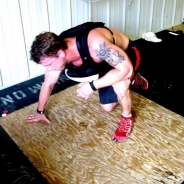
When the CrossFit Games masters competition debuted in 2010, it involved two events on Friday, a rest day on Saturday and one final event on Sunday.
How work capacity has changed.
At this year’s Games, masters competitors kicked off three days of competition with four events—the most of any Games year. The day began with a 10-barbell deadlift ladder, climbing to 535 lb. for men up to 49 years old and 375 lb. for women in the same age groups.
In 2009—the Games’ third year in existence—individual athletes of all ages made their way through a ladder of 20 barbells that maxed out at 505 lb. for the men and 375 lb. for the women.
“The masters aren’t being left out of that increase in work capacity,” said 60-year-old Terry Peters, a two-time masters competitor from CrossFit North Vancouver in Canada. “It’s pretty cool to see so many people at this age step up and compete.”
After the Deadlift Ladder, masters athletes up to 59 years old moved on to a max-distance handstand walk. Those in the oldest age division performed a max-distance walking lunge with a 30- or 50-lb. medicine ball overhead.
Immediately following the Max Distance event was the Sled Sprint, which called for a 100-yard sled drag for time. The day ended with the Run Rope event that, as the name indicated, included running and rope climbs.
“I think it’s good,” 62-year-old Mary Schwing, a three-time masters competitor from CrossFit 808 in Hawaii, said of the four events in one day. “That’s kind of how we’ve been training. The volume keeps going up.”
Bryan St. Andrews, owner of CrossFit Nittany in Pennsylvania, was there to coach his mother, Cathie. He said four events made sense.
“I think the volume’s appropriate for what they do, for what they should be doing to prepare.”
Peters expressed similar sentiments.
“Everybody who gets here trains really hard to get here,” he said. “The masters competition gets tougher every year.”
Chad Mackay, who has competed at the Games twice as an individual, was at the masters competition Tuesday morning to coach Lynne Fitzharris and Lynne Knapman.
He called the four events in 24 hours “fantastic.”
“For both of these athletes, it’s a typical training day,” said the coach at CrossFit Active in Australia.
However, had Games organizers programmed four events for one day five years ago, “It would have been a challenge.”
Mackay continued: “As the sport evolves, the athletes will evolve as well.”
Five-time masters competitor and two-time 60-plus champ Scott Olson said the masters competition has become fierce.
“Every year I’ve been back here, it’s gotten better and better,” said the 62-year-old from Front Range CrossFit in Colorado. “I like it.”
He added: “I’m 60 and I work out six days a week.”
For her part, third-year Games veteran Sharon Lapkoff of CrossFit Frederick in Maryland said four events made for a long day when she craved returning to her hotel room for some peace away from the chaos of competition.
Still, the 61-year-old approved of the upped ante.
“I think the competition’s gotten tougher. And I think they need to put more demand on us,”
She added with a smile, “I’m a glutton.”
Three-time masters competitor Becca Hartley, meanwhile, said she competes for simple reasons: to motivate others.
“Once one person can do something, everybody else has to at least try,” said the 60-year-old from CrossFit Eaton in Colorado. “That is totally the reason why I do this. I want people to say, ‘If she can do it, I can do it.’”
For complete results, visit the Leaderboard.













